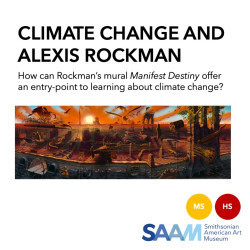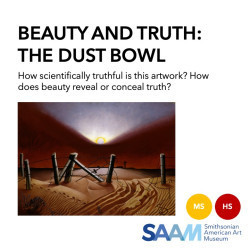Phoebe Hillemann
Teacher Institutes Educator
Smithsonian American Art Museum
As the Teacher Institutes Educator at the Smithsonian American Art Museum, I organize our week-long summer institutes for middle and high school English and social studies teachers: http://americanart.si.edu/institutes. I'm interested in interdisciplinary thinking, arts integration, and the power of dialogue in learning spaces.
Phoebe Hillemann's collections
Cultural Imagery and Stereotypes: The American Experience in the Classroom
<p>This collection focuses on two works that deal with the issues of nationality, identity and the assimilation of cultures. Mel Casas's pun-laced <em>Humanscape 62</em> combines elements familiar to many Americans: brownie desserts and a young Girl Scout (a Brownie), with traditional Mexican imagery. This pop art style-blend illustrates the Chicano experience to American culture and creates a push and pull narrative about Latino identity. Similarly, Roger Shimomura, an American-born artist of Japanese descent, contemplates repressed emotions from the time he and his family spent in World War II-era Japanese internment camps, following the attack on Pearl Harbor.</p>
<p>#APA2018</p>
<p><a href="http://americanexperience.si.edu/historical-eras/contemporary-united-states/pair-humanscape-diary-december-12/">http://americanexperience.si.edu/historical-eras/c...</a> </p>
 Phoebe Hillemann
Phoebe Hillemann
14
Climate Change and Alexis Rockman's Manifest Destiny
<p>In preparing to paint his large-scale mural, <em>Manifest Destiny</em>, a commission for the Brooklyn Museum's re-opening in 2004, Alexis Rockman consulted with climate change experts to imagine what Brooklyn might look like several centuries in the future when the glaciers have melted and sea levels have risen. </p><p>Teachers can use this painting as a starting point to discussing the issue of climate change, understanding what's at risk, and exploring mitigation strategies coastal cities might take to prevent an outcome like the one Rockman predicts.</p>
 Phoebe Hillemann
Phoebe Hillemann
6
Be The Curator with SAAM and NPG Collections
<p>Resources from the P21 Exemplar Teacher Workshop held at SAAM and NPG February 28, 2017.</p>
 Phoebe Hillemann
Phoebe Hillemann
10
Art as Argument: Dust Bowl to Climate Change
<p>How have American artists used visuals to bring attention to the pressing issues of their time? Compare and contrast a 1930s painting about the Dust Bowl with one addressing climate change made seventy years later, interpreting them in context to discover continuity and change over time. </p>
<p>Possible thinking questions for students to use with one or both paintings:</p>
<p></p>
<ul><li>Are these artworks primary sources? Does your answer depend on the context in which they are used?</li><li>What is "truthful" about these artworks? How might we use other sources to corroborate or check their truthfulness?</li><li>What do you think are the most effective media for making a compelling argument? Why? Student might consider speeches, photographs, newspaper op-eds, data visualizations like charts and graphs, videos/films, music, and visual art.</li></ul><p>Resources compiled for a March 2020 National Council for History Education (NCHE) conference session.<br /></p><p></p>
 Phoebe Hillemann
Phoebe Hillemann
11
Art as Argument: Contemporary Artists' Voices
<p>This collection explores the ways in which four American artists have used visual tools to share a message. In <em>Amendment #8</em>, Mark Bradford uses his layered paper and mixed media technique to challenge the viewer to consider how we are living up to the ideals of our founding documents. In <em>Portrait of Mnonja</em>, Mickalene Thomas references the art historical canon to address African American representation in museums. In <em>Life Magazine, April 19, 1968</em>, Alfredo Jaar manipulates a historical photograph to make visible the racial disparities it contains. And with her installation <em>Folding the Chesapeake</em>, Maya Lin begs us to see the critical importance of caring for the waterways around us. </p>
<p>Created for an April 16, 2018 webinar with Montana teachers.</p>
 Phoebe Hillemann
Phoebe Hillemann
12





